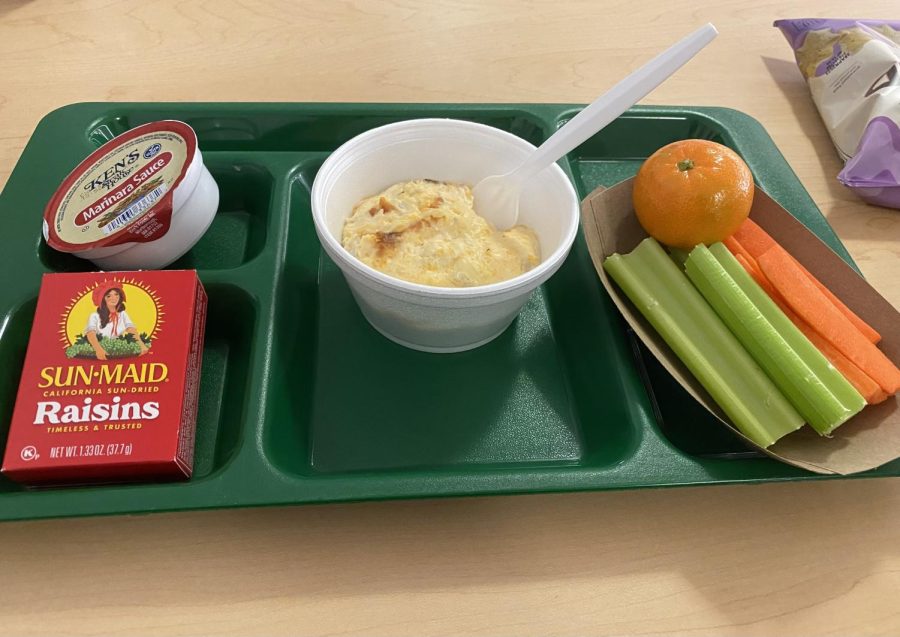The Quality of High School Lunches
How healthy are school lunches?
Buffalo chicken dip, served in the cafeteria, along with vegetables, raisins, and an orange. (Matthew Graves)
April 8, 2023

The quality of high school lunches is heavily debated. Since the first lunch was served in a school, there have been differing opinions–is it good or could it be better?
There are two sides to every story, so let me introduce you to proper research and perspectives.
There is intriguing research you should consider that suggests school food, in general, has benefits for a student’s school week. The CDC (Center for Disease Control and Prevention) explains the benefits of school meals. The CDC website highlights how school meals are nutritious for students. Research from the CDC depicted school meals as having ample whole grains, milk, fruits, and vegetables.
Along with the specific food in the meals, they add up to a better overall diet quality. Also, I think it’s important to note how school breakfast beneficially impacts a student’s school day. The CDC also suggests that “eating breakfast at school is associated with better attendance rates, fewer missed school days, and better test scores.” The school lunch has specific nutrition requirements, and school breakfast also significantly impacts students on a school-week basis.
The Food Research & Action Center (FRAC) describes how free school lunches and free meals benefit low-income students. It explains how crucial school lunch is to a student’s health and well-being and speaks to the benefit of free meals: “Research shows that receiving free or reduced-price school lunches reduces food insecurity, obesity rates, and poor health. In addition, the new school meal nutrition standards positively impact student food selection and consumption, especially for fruits and vegetables.”
Once again, this organization explains how fruits and vegetables incorporated into the school lunch program provide students with nutritional benefits. There is further information – on how school lunch participation reduces food insecurity, improves dietary intake, positively impacts health/obesity rates, and meeting nutritional requirements leading to a better learning environment.
A perspective from LiveStrong.com describes the physical and mental effects of children eating unhealthy school lunches. In early 2012, the U.S. government updated lunch standards for students; fruit and vegetables every day, giving different grades different-sized lunches, etc., but not all students eat the healthier choices schools provide.
One primary risk of eating unhealthy school lunches is a contributing factor to obesity and other weight problems. According to the Weight-Control Information Network, about a third of kids in the U.S. are overweight or obese. The effects of poor nutrition from school food go way beyond obesity. Understand this – a child who eats too much fat, sugar, sodium, or processed food is likely to develop a higher risk over time for various chronic health problems; including diabetes, kidney stones, cancer, heart disease, etc.
It’s important to note proper nutrition is also tied to better academic performance in school. According to a 2012 piece of research written by a registered dietitian on LiveStrong.com, “not getting enough essential nutrients at meals may lower kids’ IQ scores, memory capacities, fine motor skills, social skills, and languages skills into early adulthood and beyond.” Not only can unhealthy school lunches contribute to physical health problems like obesity and heart disease, but eating school food can have mental effects on students’ academic work skills and intelligence.
The Art Institutes clearly explains how more awareness needs to be brought to resolve unhealthy school lunches. The transition to healthier school lunches isn’t happening easily, but advocates remain hopeful they can impact the childhood obesity problem in the United States.
Communications Director for the Center for Ecoliteracy, Lisa Bennet, claims that “While still problematic, unhealthy school lunches and childhood obesity situations are getting attention… there is some positive change happening.” The positive change is happening to provide healthier school food and bring awareness to the effects of unhealthy school lunches. But, the important thing to note is that change only happens if people stick up to make something better.
This is something to pay attention to –“Most meals aren’t prepared from scratch and don’t use fresh fruits and vegetables. Instead, foods are frozen or made elsewhere and then heated before serving.” The statement is specifically talking about the problem faced by school lunch programs in the United States. School lunches may not always be like meals from, but they still meet important healthy criteria and I think that’s important to understand.
Both sides of the equation are equally understandable. Some would say school lunches set a satisfactory standard for feeding students, and the School Lunch Program is updating requirements to make sure of proper nutrition in school lunches. Others would argue school lunches contribute to an increase in child obesity levels, according to research, and that the quality of school lunches is not fresh and unappealing to students.
Whatever one’s perspective, the standards required keep many children from missing out on important nutrients and from going hungry. Schools will continue to change, but the need for a proper meal will always be important.








































Ms. O'Neil • May 7, 2023 at 6:10 pm
You did a nice job researching information from different views. It was an unbiased article that made me rethink my opinion.